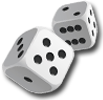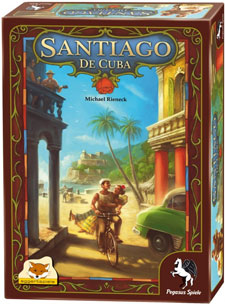



play board games
Board game reviews, strategy tips & session reports
Santiago de Cuba Board Game Review
 Stats:
Stats:
No. of players: 2-4
Amount of time to play: 40-60 min
Age requirements: 10+
Set-up time: 5 minutes
In Santiago de Cuba you must gather goods from the locals and score points by placing them on cargo ships. Once seven ships have come and gone the player with the most victory points wins.
Santiago de Cuba Rules Description:
The board for Santiago de Cuba has a road with ten spaces on it. Nine of these spaces are next to some of the locals, called Cubans. At the start of each turn the car moves one space. If it is your turn you can use the ability of the Cuban the car is next to or pay pesos to move the car forward on the road. It costs one peso for each space you move the car forward.
Most of the Cubans get you goods but a couple can get you victory points, one gets you more pesos and one allows you to own buildings. Each Cuban is marked with a colored rose and after using their ability you must move your pawn to a building matching the color of their rose. If someone uses a building you own you get one victory point.
Buildings get you pesos and victory points, allow you to exchange goods or possible ship goods. There are a couple buildings that allow you to effect the board. The customs office allows you to reduce the number of one type of good on the cargo ship to zero. The newspaper publisher allows you to flip a Cuban over. This makes it unusable until the car passes it.
The tenth space on the road is the port. It is here that you load goods on the cargo ship. To determine how many and which goods the ship wants you roll five colored dice. The dice are numbered from zero to four and match the colors of the goods in the game. The cargo ship only has room for four dice so one good will not be needed. Which dice get put on the ship is determined by the roller.
If you land on the port you may add as many of one type of good that you have but may not exceed the number on that goods die. You get two to four VPs for each good delivered and reduce the die value by the number you loaded. Then the next player gets the chance to load one type of good. Once all players pass or the ship requires no goods the game continues. If the ship still requires goods the VP per good delivered goes up and play continues in a normal fashion. Once the reward passes four VPs the ship sails even if it is not full. If all the goods dice on the ship show zeroes its demands are met and the ship sails. The player that caused the ship to be full rolls and places the dice on the ship again and then play continues.
After seven ships have left the port the game is over. Everyone totals their VPs plus you get one VP for every three goods they had left. The player with the most VPs wins the game.
Each game the set up varies as the buildings and Cubans are randomly placed on the board. This adds replay value and ensures games do not always pair the same elements together.
Quick Review of Santiago de Cuba:
Santiago de Cuba is a light-weight euro that is very accessible and has a fast playing time. It uses many common mechanics to create a fun and unique experience. It can be taught quickly and even non-gamers will enjoy it.
The art for the game is very nice. The colors and tones are rich and really add to the theme of the game. The bits are well made and look great too. The rules are easy to follow and full of helpful examples.
I like how easy this game is to teach and play. It is very accessible and that makes it easier to get it to the table than some other euros. It can really help you introduce many common concepts and mechanics to your non-gamer friends.
I also like the tactical play of this game. You must react to the changing field and make sure you are in a position to get the most VPs you can or keep your opponents from getting some.
The game can get a bit repetitive. Since nothing ever ramps up or really changes once the board is set, ship one feels very similar to ship seven. Also some buildings are just more useful than others. So even though buildings will be associated with different Cubans from game to game there are still some that will rarely be used.
Santiago de Cuba is great for anyone looking to get more non-gamers involved in their game group. The weight and speed of the game make it a great gateway game. If you are looking for a new gateway game or want an easy way to introduce your friends to euros you should pick this up.
Score and synopsis: (Click here for an explanation of these review categories.)
Strategy 3 out of 6
Luck 3 out of 6
Player Interaction 4 out of 6
Replay Value 4 out of 6
Complexity 3 out of 6
Fun 4 out of 6
Overall 4 out of 6

Leave a Reply